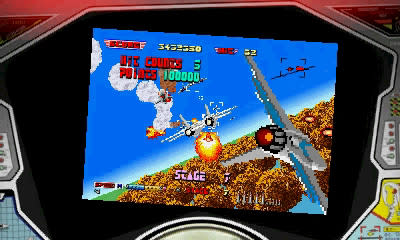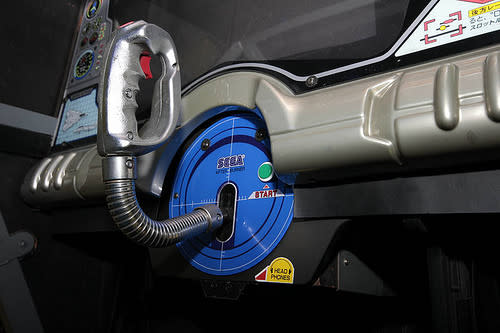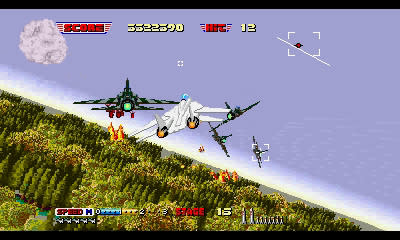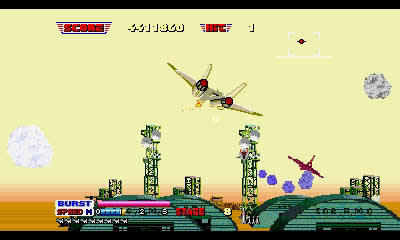3D After Burner 2: M2's quest for port perfection
"Arcade-perfect" is a term that was bandied about in the '80s and '90s as developers struggled to port state-of-the-art arcade games to significantly less powerful console hardware. Compromises were made, features were removed, and many ports that were billed as "arcade-perfect" still needed to be scaled back quite a bit compared to their cabinet counterparts.
These days, consoles boast enough horsepower to emulate classic games at a software level - virtually recreating arcade hardware in order to run original programming code, rather than porting graphics, sound, and gameplay components from scratch. Purists argue, however, that straightforward emulation lacks a certain appeal specific to original hardware. Playing the classic racer Daytona USA using an Xbox 360 controller, for instance, is a vastly different experience compared to sitting in the cockpit of the original arcade cabinet and gripping a force feedback-equipped steering wheel that fights you at every turn.
Arcade-perfect ports still elude many publishers. Japanese porting studio M2, however, sets its sights higher than mere perfection.
M2's 3D After Burner 2, released in the Nintendo 3DS eShop in North America this week, is more than an arcade-perfect port. Not only does it make great strides toward simulating the look and feel of a classic arcade game, but it also improves on the game's original design in ways that its creators planned but never fully achieved. The result is perhaps the first "complete" look at After Burner 2 as it was originally envisioned, and it's a rare treat for classic gaming enthusiasts.

M2's recreation of the 1987 aerial combat arcade game After Burner 2 emulates many aesthetic components that were ignored in previous ports, and simulates the game's many different arcade cabinet variations. Players can experience the game within a simulated sit-down arcade cabinet that rocks and sways alongside the frantic on-screen action. The screen even virtually tilts to accompany your input - a nostalgic touch that will rekindle memories for veteran players.
If your memories of After Burner 2 are tied to one of the cheaper-to-produce cabinet variants, M2 also has you covered; two different upright cabinet versions are simulated in 3D After Burner 2. While these versions don't boast the deluxe Double Cradle version's full range of motion, they have their own quirks and charm. Light-up buttons on a virtual control panel flicker to indicate enemy lock-ons, giving a brief window for players to react appropriately and counterattack. These elements are difficult to simulate outside the context of the original arcade version, and were omitted in previous ports.
M2 completes the illusion with optional environmental sound effects that simulate the noises made by joystick movement and button presses in the original arcade version, even going so far as to record these sounds directly from a preserved arcade cabinet. If you remember the distinct click of After Burner 2's missile button, M2 has lovingly preserved and recreated it in 3D After Burner 2.

"For all the previous titles, my colleague Chibi-Tech, and Matsuoka, the director, would take a trip down to Sega's long term storage facility and record all the sounds that the motors, buttons, and triggers make," M2 sound director Manabu Namiki said during a recent interview, referencing the studio's previous work in simulating environmental sound effects for 3D Space Harrier and 3D Galaxy Force 2. "But for After Burner 2, I had a chance to go with them and climb into those machines, trigger the sounds, and record them."
Namiki continues: "If you turn on the environmental sounds in 3D After Burner 2, when it's idling, you can hear the [internal cooling] fans, as well as the machinery that drives the cabinet. This is actually recorded from a real machine. This too is part of the environmental sounds."

M2's port doesn't simply recreate the game in its original form, however. Hardcore fans will appreciate the inclusion of an "Extra BGM" option that enables a melody track that accompanies the game's musical themes. Originally planned for inclusion in the original arcade game but omitted before production, the "melody" versions of After Burner 2's tracks were later featured in official soundtrack releases, downgraded ports, and one faithful adaptation available only in Japan for the Sega Saturn.
"There were soundtrack CDs for After Burner 2 that were released, and these CDs had BGM versions with melodies that were not present in the arcade version," Namiki explains. "These 'melody versions' did not actually exist in either the Japanese or overseas versions of the ROM. This leads one to believe that they existed only in the original developer's data. I thought that this data may well be lost to the world and didn't exist anymore. But surprisingly, it did still exist and [Sega producer Yosuke Okunari] provided it to us."
Okunari further details the restoration process: "It turns out that the CD version of After Burner 20th Anniversary Box was digitally re-recorded, and these 'melody versions' were supposedly the hardest part of the remastering effort. The original composer, [Hiroshi Kawaguchi], actually had the original 1987 data. That is, on an ancient 8" floppy disk."
Reassembling the preserved data presented its own challenges, however. "I had them show me the data they recovered from the floppy, and it wasn't final data that could be burnt onto the final ROM, or play on a mass-produced arcade board," Nakimi said. "I think what they had on that first CD was a recording off a development board that used an [in-circuit emulator]. That's probably what the final melody version was. So what I had to do was go and convert the data to something that would run on a mass-produced arcade board, and that's what's being emulated on 3DS."
After Burner 2's soundtrack is iconic and memorable, but the addition of melodies makes the original tracks seem empty and incomplete in comparison. It's rare to experience these tracks in the context of the original arcade version of After Burner 2, and M2's port brings to life its sound designer's original vision that was never previously fulfilled.

After Burner 2's original designers also lamented the fact that plane-versus-plane dogfighting was never fully implemented in the final arcade release, despite being a part of the original proposed design.
"If you go back and look at interviews with the developers back then, they talk about the things they wanted to do but couldn't," Okunari said. "One of those was 'dog fights.' They said they ran out of time to do it. They talk about how fighter planes are all about dog fights. I don't know how far the original developers thought about it at the time, but we decided to actually do that, within After Burner 2's architecture."
After completing M2's port, players can experience an alternate version of After Burner 2 that fully realizes the arcade team's original vision for the first time ever. 3D After Burner 2's unlockable Special Mode implements defining features from the 2006 arcade sequel After Burner Climax. Players shoot down enemy planes to fill a "burst" meter, which can then be triggered to slow down time in order to dodge enemy fire and retaliate with a barrage of rapid-fire missiles.
Special Mode also changes After Burner 2's bonus stages completely, putting players in direct combat with a single enemy plane for their duration. Throughout these levels, veteran players are forced to adapt their decades-old strategies for new dogfighting mechanics that demand a high degree of white-knuckle aerial dexterity.
"We were able to take a fresh look at this game and do what we did because of the efforts of our main programmer, [Akira] Saito, and [Ikaruga director] Hiroshi Iuchi, who is a designer who comes from a different background," M2 president Naoki Horii said. "Both Saito and Iuchi added their own content into the Special Mode. Iuchi joined mid-way through the project. While Saito said he wanted to put in something similar to Climax from the very beginning, Iuchi came along and said, 'I wanna see some dogfights.' So in the end, both got put in and Iuchi did the balancing."

For purists, 3D After Burner 2 perfectly recreates every element of the original arcade game, from its precise analog controls to its delicate audio balance between sound channels. It's not just arcade perfect, though; it resurrects fascinating cutting-room-floor material that was long thought lost, essentially creating a "director's cut" version of a landmark arcade game.
3D After Burner 2 is more than just a port - it realizes a classic game's full potential, and presents an alternate look at how it might have turned out if development had progressed differently. It's a labor of love for devoted fans, and it's an important step in the right direction for how classic games should be preserved and remembered.
[Images: Sega]


